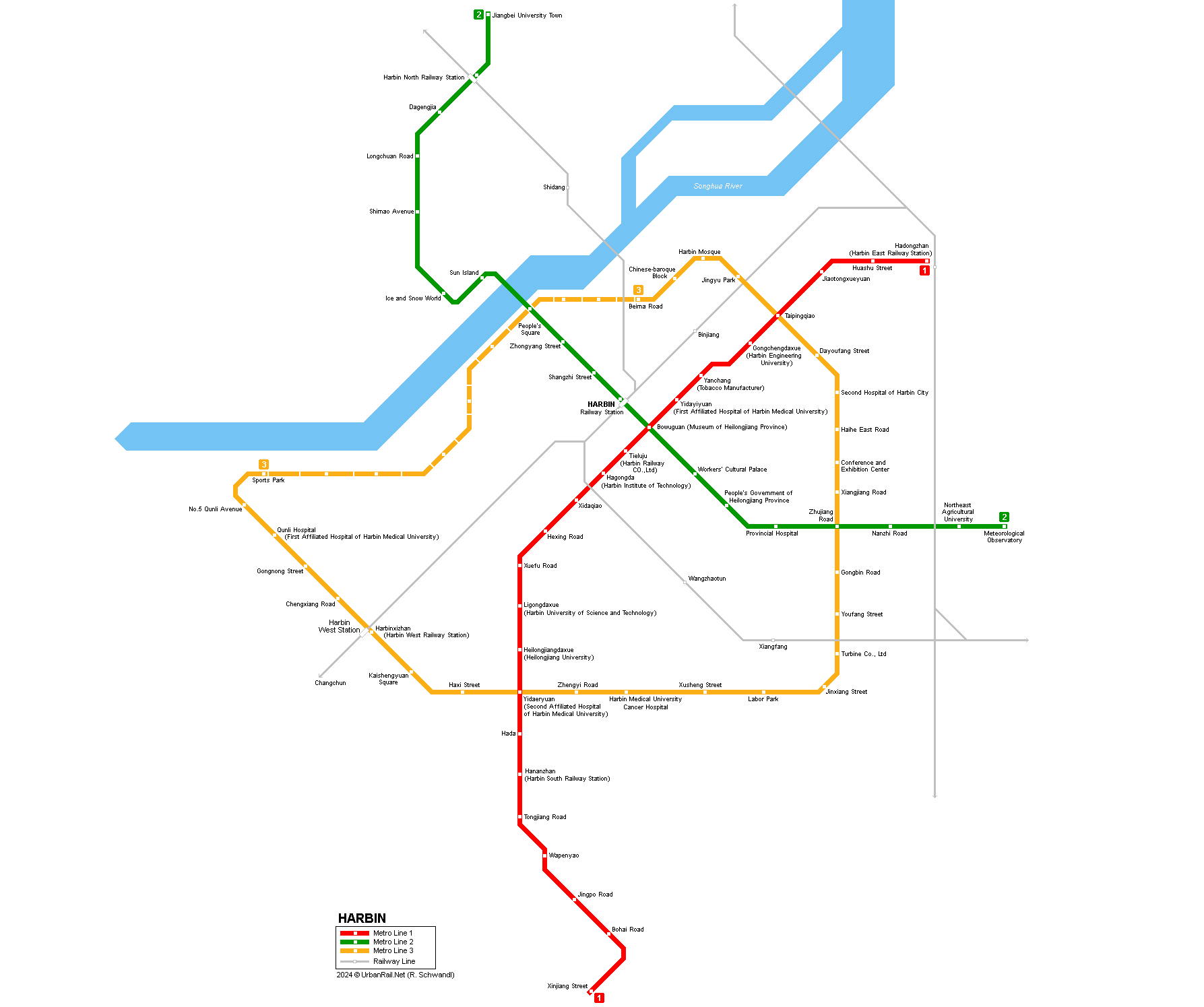
|
[ UrbanRail.Net ] [ Europe ] [ Americas ] [ Asia ] [ Africa ] [ Oceania ] [ News ] [ Books ] [ Links ] |
|
HARBIN
|
| China |

|
System
|
|
Harbin is situated in the northeast of China, in Heilongjiang province, with some 5 million inhabitants.
|
|
Line
1
|
|
Line 1 is 26.1 km, all underground. 26
Sept 2013: Hadongzhan (Eastern Railway Station) - Hananzhan (South
Station) (17.5 km)
|
|
Line
2
|
|
28.7 km north to east line 19 Sept 2021: Jiangbei University Town - Meteorological Observatory (28.7 km)
|
|
Line
3
|
|
37.6 km circular line 26
Jan 2017: Yidaeryuan - Harbinxizhan (4 km)
|
|
Photos
|
|
|
|
Links
|
|
Harbin Metro (Official Website) Harbin Metro at Wikipedia
|
| Impressions |
|
In June 2016, Craig Moore reports from Harbin: Unlike most large Chinese cities, Harbin is not famed for its long history. Essentially a late 19th Century settlement, it expanded as a rail head and administrative centre for the Trans Siberian/Manchurian Railway. This rail legacy now includes a Metro - a single, fully underground line of 17.5km, with 18 stations. Opened in 2013 it was constructed at a time when there was a rich bounty of Metros being built in the PRC - between 2012 and 2014 eight new Metros opened – with most based on a reasonably uniform design blueprint. Interestingly, Harbin is different within this group in two ways. Firstly it is, apart from Zhengzhou, the only one of the group not to have expanded since inauguration and, secondly, it has a very unique feel – not following the design blueprint in most respects. The line runs from the northeast of the city to the south, with the main stations being Bowuguan and Tieluju. The current alignment ignores many of the main trip-generating points in the city. Clearly this will change as the system grows, but at the moment, several major areas of the centre are not served. This might be one of the reasons that the line is not massively crowded.
The platforms have limited information- a strip map above the doors on the full platform screens and a small station vicinity map. The platforms have small amounts of seating and also have TV screens at right angles to the platform screens which provide next-train information in Chinese only. There is audio information in Chinese and English but it is very difficult to hear. The platform areas are clad in large tiles which are a mix of white and deep, rich tones ranging from mustard to rust to burnt orange. They look very smart, clean and modern and when juxtaposed with the ornate, historic looking trimmings, such as small wall laps, located on the platforms and entrances, you get a very different and pleasant environment. Most of the stations have quite deep side platforms (Bowuguan in staggered) although there are a couple of stations with island platforms (e.g. Hexinglu) outside the central area. In general everything is well kept and the platform areas are very nice indeed. One other thing of note is that the system doesn’t appear to be overrun by staff, as can often be the case in China, and the staff are very friendly and helpful. Services run from 0600-2130 and the base headway is 8 mins. The stock was built by CNR and it is very different from most stock of that era. The trains are made up of six-car sets, the front being quite a flat structure and the solid white sides are interrupted by pale orange doors and an occasional abstract snowflake arrangement made of different sized dots (also in orange). The interior is very smart. Again, predominantly white, with deep orange side seating and each carriage end having a red/purple colour scheme, with the dot arrangement replicated in orange. It looks very smart indeed - as it is a through train one can see the carriage divisions very clearly due to the stark colour contrasts. There is a small TV which explains next station in Chinese only but, as on the platform, there are Mandarin and English announcements. The strip map above the door is in English and is electric with mini dots being illuminated as the train progresses on its journey. For some reason, this map has a kink in the line and is not a simple, straight progression. As for the 34min journey between terminals – well, it is smooth and quite speedy and dwell times are sensible. |
|
Photos
|
|
|
|
|
2013 © Robert Schwandl (UrbanRail.Net)